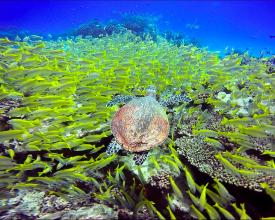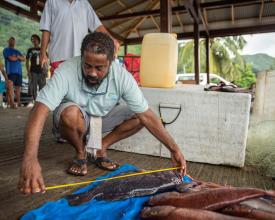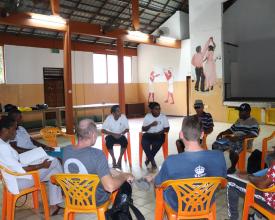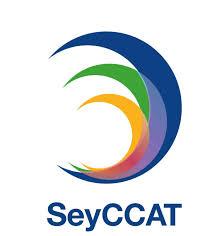
Primer canje de deuda por naturaleza para la conservación de los océanos en Seychelles

Desde 2013, el gobierno de Seychelles identificó la necesidad de reducir la vulnerabilidad económica y la dependencia del turismo, aumentar el PIB de los sectores marinos, crear empleos de alto valor y garantizar la seguridad alimentaria mediante la protección y el uso sostenible de los recursos marinos.
El Seychelles' Conservation and Climate Adaptation Trust (SeyCCAT) se creó en 2015 junto con el Gobierno de Seychelles y The Nature Conservancy. Las partes concluyeron el primer canje de deuda por naturaleza para la conservación de los océanos, mediante una reestructuración de la deuda de 21,6 millones de dólares. SeyCCAT recibió la gestión de dos innovadores acuerdos de financiación, el Blue Grants Fund (por un total de 11,6 millones de dólares) y el Blue Endowment Fund.
SeyCCAT es ahora un fondo fiduciario de conservación encargado de movilizar recursos para impulsar la economía azul de Seychelles.
Contexto
Défis à relever
El futuro de Seychelles plantea numerosos retos en lo que respecta al cambio climático, la subida del nivel del mar, la decoloración de los corales, la erosión del litoral, el control de las especies exóticas invasoras, la explotación sostenible de las poblaciones de peces y la gestión eficaz de las zonas protegidas.
Para mitigar las amenazas a su economía insular, el Gobierno ha decidido reducir la dependencia del turismo fomentando la investigación y el desarrollo en agricultura, pesca, energías renovables en alta mar, prospección de hidrocarburos, fabricación a pequeña escala y la economía basada en el conocimiento del sector financiero en alta mar.
La visión holística del océano y su futura contribución al crecimiento económico del país exige el compromiso del gobierno, el sector privado y las comunidades para equilibrar el desarrollo del sector con la planificación y la aplicación de medidas de conservación.
Una herramienta importante es el desarrollo de la SeyCCAT, que inyecta un capital significativo en los esfuerzos de Seychelles por proteger su medio marino y dinamizar esta nueva economía.
Ubicación
Procesar
Resumen del proceso
Para establecer mecanismos de financiación combinada, es fundamental una sólida asociación público-privada. El sector privado aporta el capital y el riesgo se reduce aprovechando los mecanismos públicos, como la deuda pública, las garantías parciales y los préstamos en condiciones favorables para reducir el riesgo de impago del sector privado. Para aumentar la confianza de los inversores, una organización no gubernamental y sin ánimo de lucro como la SeyCCAT, en cuyo Consejo de Administración están representados todos los sectores, proporciona el vehículo tan necesario para gestionar estas transacciones y que los ingresos se utilicen en función de lo acordado por todas las partes.
La independencia de la SeyCCAT, con sólo 3 de los 9 miembros del Consejo representando al Gobierno, significa que los departamentos gubernamentales, las agencias, la sociedad civil y las empresas pueden solicitar financiación de la SeyCCAT. Sin embargo, es importante que estos grupos elegibles puedan acceder a los fondos, por lo que la puesta en marcha de iniciativas de capacitación es de suma importancia para permitir su absorción.
Bloques de construcción
Colaboración público-privada (CPP)
Una Asociación Público-Privada (APP) es fundamental para el éxito de mecanismos de financiación mixta como el canje de deuda y el bono azul soberano. El Consejo de SeyCCAT incluye representantes del gobierno, el sector privado y la sociedad civil.
El compromiso privado en una asociación de este tipo es obligatorio para atraer a inversores de capital privado, que no podrán financiar únicamente instituciones públicas, debido a las políticas internas de los donantes.
Factores facilitadores
- El sector privado aporta el capital
- Mecanismo de reducción del riesgo mediante garantías parciales.
- La deuda pública puede apalancarse.
Lección aprendida
- Requiere la comprensión de los factores que son importantes para todas las partes, para garantizar que el acuerdo al que se llegue satisfaga las preocupaciones de todas las partes.
Autonomía e independencia del fideicomiso
SeyCCAT debe establecerse con carácter no gubernamental, con su autonomía e independencia para gestionar eficazmente los fondos. Participa en el aumento de la confianza de los inversores.
No debemos ser vistos como un brazo más del gobierno, sino tener autonomía financiera y de decisión, al tiempo que consideramos al gobierno como un socio clave. Una de las razones es que los donantes tienen ciertas políticas internas que les impiden financiar directamente al gobierno.
Somos transparentes en derecho, lo que fomenta la buena gobernanza y la transparencia en los procesos de toma de decisiones con la participación de todas las partes interesadas y socios.
Factores facilitadores
- Consejo con buena representatividad
- Capacitación de los solicitantes de proyectos admisibles para acceder a los fondos
Lección aprendida
La capacidad de trabajar sin interferencias del gobierno ni de donantes privados, salvo lo acordado al principio, proporciona a la organización la independencia y autonomía necesarias para actuar en beneficio del medio marino.
Representatividad del consejo
El Consejo de la SeyCCAT está compuesto por miembros de los sectores público y privado y de la sociedad civil, con mayoría del sector privado y la sociedad civil. Pone sobre la mesa los puntos de vista de todas las partes interesadas, de modo que recibimos orientación tanto del sector privado como de las ONG. Se trata de un proceso tripartito de toma de decisiones, que aporta un fuerte consenso, lo que a su vez mejora la implicación de todas las partes interesadas y genera mejores resultados.
Factores facilitadores
- Voluntad de que todos los agentes participen en la orientación de los trabajos de la SeyCCAT.
- Toma de decisiones en conjunto con el acuerdo de todos.
Lección aprendida
La representación aumenta la legitimidad y permite que todas las voces estén representadas, pero hay que procurar no desequilibrar la balanza asegurándose de que los cargos de Presidente y Tesorero no se asignen a los de un solo sector.
Capacitación para acceder a las oportunidades de financiación
Es esencial capacitar a los miembros de la comunidad para que puedan acceder a las oportunidades de financiación que ofrece la SeyCCAT. Esto incluye sesiones sobre cómo redactar una propuesta de proyecto, elaborar un presupuesto y presentar informes, entre otras muchas habilidades de gestión de proyectos.
Hay distintos modelos de capacitación. Con los jóvenes, conseguimos que jóvenes expertos enseñen a otros jóvenes, según el principio de "entre iguales". Contamos también con un equipo de tutoría especializado, que apoya todo el ciclo de solicitud del proyecto. También nos asociamos con organizaciones existentes que tienen experiencia en la formación de gestión de proyectos.
Creamos capacidades para las solicitudes a corto plazo de la SeyCCAT, pero participa en la creación de capacidades de por vida para que las personas puedan solicitar y gestionar otros proyectos más allá de la SeyCCAT.
Hasta ahora, la SeyCCAT ha capacitado a unas 200 personas.
Factores facilitadores
- Asignación de fondos para permitir el desarrollo de capacidades;
- Asociaciones con organizaciones expertas en desarrollo de capacidades y gestión de proyectos.
Lección aprendida
- Se trata de una inversión a largo plazo y, como suele empezar inmediatamente, significa que durante los primeros días habrá límites a la absorción de fondos.
Impactos
La SeyCCAT apoya la aplicación de un plan espacial marino para designar el 30% de la Zona Económica Exclusiva (ZEE) de las Seychelles.
La SeyCCAT ha creado inclusión social en el desarrollo de la economía azul, mediante el desembolso de 700.000 dólares anuales, en forma de subvenciones para avanzar en la protección marina, la pesca sostenible y la economía azul. Desde su lanzamiento en 2017, ha concedido más de 1,5 millones de dólares en subvenciones a más de 25 beneficiarios que ejecutan un total de 33 proyectos. Las subvenciones han beneficiado a áreas marinas protegidas como el Parque Nacional Marino de Curieuse, Aldabra, la isla de los Pájaros, la isla de Alphonse y Farquhar, así como a la evaluación de referencia de la biodiversidad marina de la isla de Fregate, una aspirante a AMP.
Más de la mitad de los fondos se han destinado a proyectos dirigidos por mujeres o que han beneficiado a mujeres, y un tercio a proyectos dirigidos por jóvenes o en los que los jóvenes son los principales beneficiarios. 23 proyectos han beneficiado a la pesca artesanal a pequeña escala.
Beneficiarios
- SeyCCAT
- Sociedad civil
- Departamentos y agencias gubernamentales
- Empresas privadas
- Seychelles
Objetivos de Desarrollo Sostenible
Historia
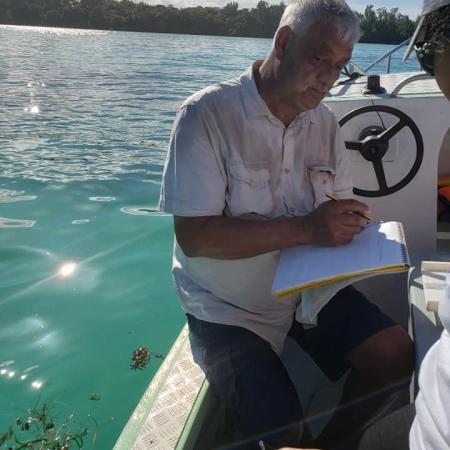
SeyCCAT es más que un donante de proyectos. Para nosotros no sólo es importante lo que hacemos, sino también cómo lo hacemos. Entendemos que nuestra ambiciosa Visión sólo puede hacerse realidad a través de las personas y organizaciones en las que invertimos, y que nuestro éxito depende del suyo.
Crearemos el espacio para nuevas ideas, ayudaremos a que esas ideas evolucionen, forjaremos nuevas colaboraciones creativas e impulsaremos el impacto individual y colectivo. Capacitaremos a los líderes locales y regionales del mañana y difundiremos lo que nosotros y nuestros socios aprendamos.
Creemos que demostrando nuestro compromiso con:
- Idear e Incubar;
- Las personas y las asociaciones;
- Capacitar e invertir; y,
- Aprender y compartir
.... que juntos conseguiremos asegurar nuestra Visión para:
Que el océano y las islas de Seychelles sean administrados por el pueblo de Seychelles, generando beneficios sostenibles para las generaciones futuras.
Aunque SeyCCAT surgió en respuesta a una crisis financiera en 2008 para apoyar al Gobierno de Seychelles con la reestructuración de su deuda, el modelo ha demostrado ser resistente a las crisis, ya que ahora se mantiene vibrante durante COVID_19. El modelo SeyCCAT sigue atrayendo fondos adicionales para apoyar el liderazgo de Seychelles en materia de océanos y clima. Además, actúa como fuente de optimismo ante el colapso del turismo, ya que la financiación sigue estando a disposición de diversos actores, incluidos los gestores de áreas marinas protegidas, para financiar sus iniciativas.


